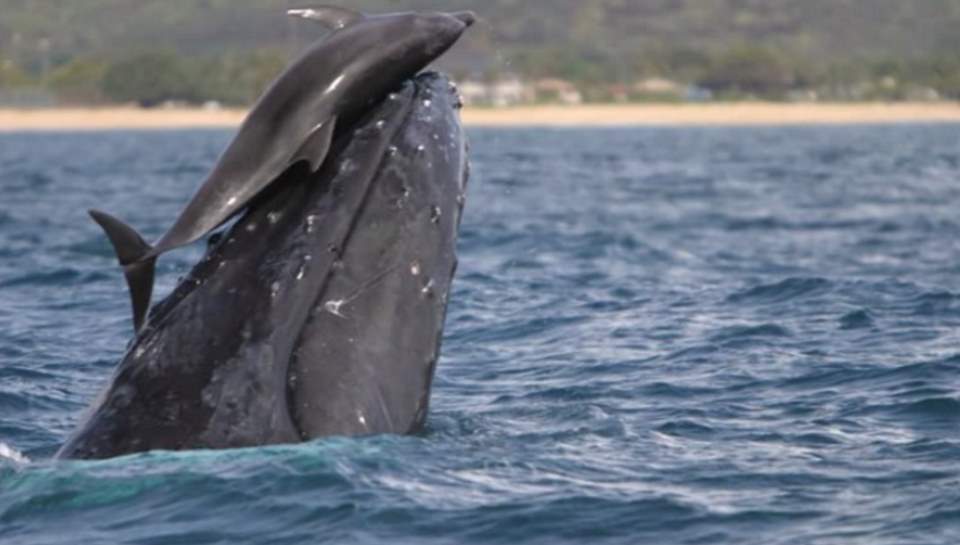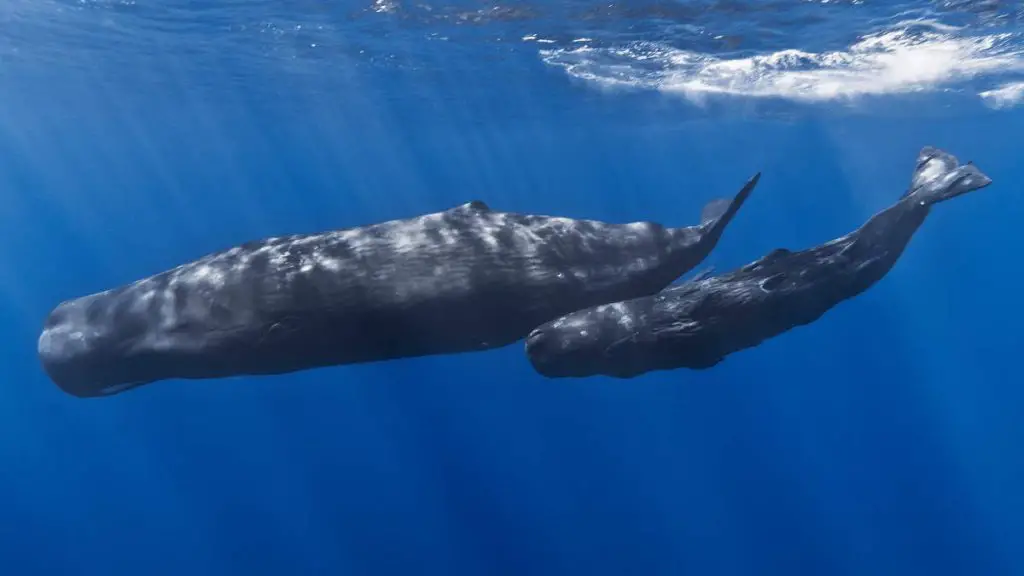Humpback whale (scientific name: Megaptera novaeangliae) is a species of baleen whale (also called toothless whale). Baleen whales have a special net-like epidermal modification called baleen in their mouth, which is used to filter food from the water. Here are 10 amazing Humpback whale facts.
1. An adult humpback whale is as big as a school bus
They’re not the biggest whales on earth (that title goes to blue whale), but, still, they can grow up to 12-16 meters (39-52 feet) in length. They can also weigh about 36,000 kg (79,000 lb).
And their tails grow up to 18 feet (5.5 meters) wide. Also, females are slightly larger than males.

Their babies also big
The mother carries her young for a gestation period of about 11.5 months.
The babies measure between 10 and 15 feet (3 to 4.5 m) long and weigh up to a ton (907 kg).
Calves suck milk, about 600 liters per day in about 1 year, and they don’t stop growing until they reach 10 years old.
3. They don’t have teeth
They don’t have teeth in their mouth. As explained above, they have a special net-like epidermal modification called baleen in their mouth, which is used to filter food from the water. Humpbacks primarily feed on krill and plankton.
4. They play with dolphins!
Scientists have observed unusual interactions between bottlenose dolphins and humpback whales as dolphins rode the heads of whales: the whales lifted the dolphins up and out of the water, and then the dolphins slid back down.
The two species seemed to cooperate in the activity, and neither displayed signs of aggression or distress. They were “playing”, according to scientists.
5. Humpback whales are the only whales with tubercles
A distinctive feature of the humpback whale is the presence of knobs, called tubercles, on its head.
Each tubercle is essentially a gigantic hair follicle, rich in nerve cells.
While scientists aren’t entirely sure about the function of the tubercles, they think they help with whale sensory currents or the movement of prey.
It also improves what’s called the “tuberculate effect,” the maneuverability of whales’ wings in the same way as improving the flight of hooks on an owl’s wing.
6. Male humpback whales sing
Both male and female whales vocalize grunts, sparks, and pearls, while only the male sings. Males produce a complex song lasting 10 to 20 minutes, which they repeat for hours. The purpose of their singing is not clear, though it may have a role in mating.
The song is the same for all whales within a single group, but evolves over time and is different from any other whale cell.
A male humpback sings for hours, repeating the same song over and over. According to NOAA, a humpback whale’s song can be heard up to 30 kilometers (20 miles) away. This brings us to one of the most amazing humpback whale facts:
7. Some scientists think humpback whales can teach us about “alien languages”
Some scientists think humpback whales have “conditional probability” in their language. This is one of the most important properties that make a language “language”.
In probability theory, conditional probability is a measure of the probability of an event occurring, given that another event has already occurred. In short, the probability of A under condition B.
Laurance Doyle, a research scientist at SETI suggests if we can somehow understand humpbacks’ language, we could understand the language of an alien if we make contact.
8. They are strong swimmers
Found in oceans and seas around the world, humpback whales typically migrate up to 25,000 km (16,000 mi) each year. Humpbacks feed only in summer, in polar waters, and migrate to tropical or subtropical waters to breed and give birth in the winter when they fast and live off their fat reserves.
Humpback whales often float above the water before splashing back down. This is called breaching.
Also with their tails or flippers, they slap the water. These behaviors can be used to communicate with each other, and can also be used to show dominance and health during the mating season.

9. They are usually easily approachable
They are curious animals. Some individuals (referred to as “friendlies”), approach boats closely and stay near for many minutes. Because of this, humpbacks became the main actors of whale tourism around the world.
They even understand when humans try to help them. In 2011, Michael Fishbach, co-founder of The Great Whale Conservancy, his family, and friends rescued a Humpback Whale from fishnets, and after being freed, the whale showed amazing appreciation to the rescuers. Their efforts were captured on film.
10. They have a diverse repertoire of feeding methods, including the bubble net technique
Their diet consists mostly of krill and small fish. Humpbacks have a diverse repertoire of feeding methods, including the bubble net technique.
Bubble-net feeding is a complicated, highly synchronized effort that shows high biological intelligence. One whale usually leads the endeavor, diving deep and then rising up to the surface.
From deep below, it’ll begin to blow air to create bubbles. It confuses and traps the fish above. Then, the rest of the team follows, creating a cumulative fence around the prey, like a corral. The whales then gather inside the bubble net and rise to the surface, mouths wide open.
Some not-so-amazing humpback whale facts
Like all big whales, they are subject to the whaling industry worldwide which severely reduced their numbers. The species was listed as vulnerable in 1996 and endangered as recently as 1988.
Once hunted to the brink of extinction, its population fell by an estimated 90% before a 1966 moratorium. While stocks have partially recovered, entanglement in fishing gear, collisions with ships, and noise pollution continue to impact the population of 80,000.
Today, their numbers are increasing, so in August 2008, the IUCN changed humpback whales’ status from Vulnerable to Least Concern. But, unfortunately, four out of the 14 distinct population segments are still protected as endangered (Central America, Western North Pacific, Arabian Sea, and Cape Verde Islands/Northwest Africa), and one is listed as threatened (Mexico).
Sources
- “What humpback whales can teach us about alien languages” on Vox.com
- Conditional probability on Wikipedia
- Humpback Whale on Wikipedia
- Humpback Whale facts on Oceana.org
- Sloth Facts: 10 Amazing things about these adorable mammals - August 12, 2022
- 10 Amazing Koala Facts - February 18, 2022
- 10 Amazing Humpback Whale Facts - December 22, 2021


